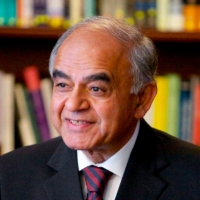India on the Brink of Change
How did the 1991 financial crisis help to reshape India’s static economy?
September 1, 2001
At the beginning of the 21st century, I feel about India as I believe my parents did on August 14, 1947, the day before India gained its independence.
On that day, Prime Minister Jawaharlal Nehru gave voice to their sentiments, saying, “We end today a period of ill fortune and India discovers herself again. The achievement we celebrate today is but a step, an opening of opportunity to the greater triumphs and achievements that await us. Are we brave enough and wise enough to grasp this opportunity and accept the challenge of the future?”
The brutal fact is that India’s economic failure over the past half-century has hidden so many of the triumphs and achievements that Nehru dreamed of. In fact, our country is further behind today, relative to the rest of the world, than it was at Independence from Britain.
Nehru did not realize that socialism would lead to statism — which, in turn, would seriously compromise the very freedom that he had fought so hard to win. In essence, it managed to suppress the innovative energy of his people.
Fortune, however, works in mysterious ways. Just when we Indians were resigned to our fate and had begun to believe that we were a hopeless case, our situation changed. Based on modest reforms in the 1980s, India’s growth rate picked up from the historic 3.5% “Hindu rate of growth” to 5.6% a year for the 1980s.
The net effect? Our country’s middle class began to grow vigorously. But this growth rate proved unsustainable because it was based on excessive borrowing, which plunged us into an unprecedented financial crisis in 1991.
One could argue that India needed the crisis. It forced us to undertake the most comprehensive reforms in our history. The reforms have released entrepreneurial energies the likes of which we have never seen before. They have also changed the mindset of the Indian people.
Meanwhile, the world has also changed to our advantage. The communications revolution has brought the world into our homes — and we have come to realize how far we have been left behind.
The rapid flows of global capital have made us aware that lack of capital need not be an obstacle — and that we need not be capital-starved for all time to come, since we can supplement our needs with imported capital.
The information technology revolution and the Internet have come along and leveled the playing field, bringing with them the promise of solving some of India’s most intractable problems of development. In particular, they may do so much quicker than we could ever have imagined.
India thus enters the 21st century on the brink of the biggest transformation in its history. The changes are more fundamental than anything that the country has seen. They hold the potential to transform it into an innovative, energetic economy of the 21st century.
We have realized that our great strength is our people. Our great weakness is our government. Our great hope is the Internet. Perhaps at last we have found the right set of policies.
And there is a growing will to implement them. It is not going to be easy, for the old statist policies have enriched the vested interests, especially the state personnel — whether elected, appointed or their hangers-on.
But change will take place because too many know too much — through television, cable, and increasingly the Internet.
Millions of Indians talk to their relatives overseas regularly. They may not be able to articulate economic policies, but they see clearly enough who has power and who does not — and whose is legitimate and whose is not.
While the impulse to control will diminish only slowly in a country with a vast bureaucracy, the flood of information that will wash every village will force transparency in the government and lead eventually to prosperity.
It is ironic that India’s Congress Party — made up of old politicians which liberated us in 1991 with the economic reforms — is now trying to stall them, all in the name of the poor.
The insolent technocrats at the Department of Telecom are so bent on preserving their monopoly — the consumer be damned — that they sabotage every initiative to bring us competition and world-class communications.
The unions in public-sector banks go on strike every time there is talk of reform and privatization. Meanwhile, the right wing of the Bharatiya Janata Party wants to close the economy to foreigners — in the name of nationalism.
And the left-wing intellectuals in the universities continue to fill the minds of our young with postmodern, postcolonial theories of multinational conspiracies and other variants of impotence.
Finally, India’s old protectionist businessmen still rely too much on natural resources, cheap labor and government favors. They do not invest in capabilities to produce differentiated goods and services that create value for demanding global consumers. They continue to be trapped in their old ways and want to compete solely on the basis of price.
In the end, this attitude tends to suppress wages. What they do not seem to realize is that to keep wages low is to compete to see which country can stay poor the longest. These are the many forces of reaction that could stop the million reformers. They fight the reforms at every step — but they fight a losing battle.
Adapted from "India Unbound" by Gurcharan Das. Copyright © 2001 by Gurcharan Das. Used by permission of the author.
Read previous
The Equal Opportunity Army
August 31, 2001
